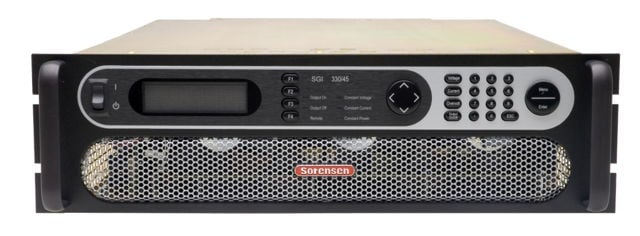Transient response is a measure of how well a DC supply, such as the Sorensen SG Series, copes with changes in current demand or how well the supply follows load impedance changes. This is an important specification in many applications, such as mobile phone testing and testing automotive relays and fuses. A good understanding of this power supply characteristic will help you choose the right supply for your test application.
 In addition to having the highest power density in the industry, the Sorensen SG Series has a low noise output and exceptional load transient response.
In addition to having the highest power density in the industry, the Sorensen SG Series has a low noise output and exceptional load transient response.
For example, when testing mobile phones, the DC power supply simulates the mobile phone's internal battery. When the phone begins to transmit, the current increases very quickly.
A mobile phone battery can easily handle this change in load current, but a programmable switching supply may not have a fast enough transient response to prevent false test failures. Instead, use a linear supply for this application. Although linear supplies are less efficient than switching supplies, the power requirements are low, and the transient response of a linear supply is, in general, better then a switching supply.
Testing automotive relays and fuses is, however, another matter. For this application, the programmable DC power supplies must provide high currents at voltages up to 30 VDC, and typically, the power required is 5 kW to 10 kW. When performing this test, a large DC output voltage overshoot could damage the relay or fuse. To prevent this from happening, you want a supply that will control the DC output current instantaneously from zero to maximum output or from maximum to zero output.
To get a faster transient response, you sometimes have to settle for more ripple and noise. Using large capacitors in the output filter will limit the ripple and noise, but will make the supply slower to react to fast changing loads. To increase transient response, you can use a supply with smaller output filter capacitors, but that will increase noise and ripple.
Another way to increase transient response is to speed up the internal voltage control loop. This may not work in all applications, though. A very fast internal voltage control loop will shorten transient response times, but may cause overshoot or undershoot, which may damage a device under test (DUT).
A practical way to limit overshoot and undershoot is to use a pre-load. Connecting a pre-load in parallel with the DUT and the DC output of the programmable power supply will now reduce the percent of current change, and as a result, reduce the amount of overshoot or undershoot.
To see how this works, consider the case where a test setup uses a preload that is equal to the test load at full current. Before power is ever applied to a DUT, the power supply is already supplying 50% of full load. When the DUT is energized, the current output will increase, but only by another 50% of full load. Instead of going from 0 to 100%, the supply output goes from 50% to 100%. This smaller change it is much easier on the supply and nearly eliminates high-voltage overshoots, thereby preventing any damaging to the DUT.
Simple inexpensive resistive loads can be used as pre-loads, and any resistance value that is close to the DUT load will work just fine. Any ratio from 40% to 60% of full load will improve the supply's transient response and eliminate overshoot and undershoot.
A disadvantage of using a pre-load is that twice as much DC output current is required for a particular test. AMETEK switching power supplies are, however, very cost-effective, and adding, additional power is relatively inexpensive, approximately 50 cents per watt. This makes using pre-load a much cheaper and more practical approach than specialized power supply sub-systems for applications where fast transient response without overshoot or undershoot is important.




